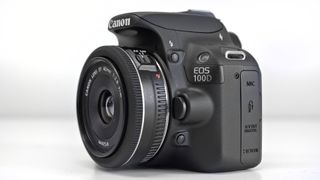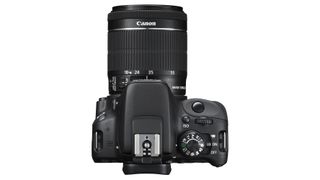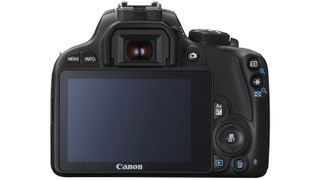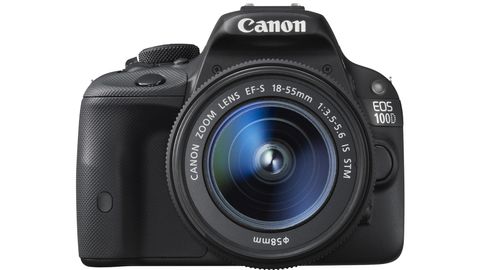Why you can trust TechRadar
From its announcement, we were pretty excited about the Canon EOS 100D. What the Canon engineers have managed to achieve in shrinking down the key components of the DSLR is pretty remarkable, especially with a sensor that is claimed to be similar in performance than the Canon EOS 650D.
Happily, we have not been disappointed by the image performance of the Canon EOS 100D. That 18 million pixel sensor is capable of resolving lots of detail, with minimal evidence of image smoothing at lower sensitivities.
Colours from the Canon EOS 100D are also excellent, being nice and vibrant without going over the top. Having the ability to experiment with Picture Styles also gives you the opportunity to boost elements such as saturation if you think the scene requires it.

Automatic white balance does a good job in the majority of conditions, but it does tend to favour slightly warmer tones when faced with artificial lighting. Switching to a more appropriate white balance setting is quick enough, though, if you're not satisfied with its performance.
The 100D's evaluative metering, as general-purpose metering is known on Canon DSLRs, is a reasonable performer, helping the camera to produce balanced exposures in the majority of conditions. However, if a scene has high contrast the camera struggles and it will under- or over-expose the depending upon the brightness of the subject under the active AF point. In some ways it acts more like centreweighted, or even spot metering because the exposure is significantly skewed towards getting the subject under the AF point just right.
Noise performance is very good, with lots of crisp detail even at mid-range sensitivities such as ISO 400. From around ISO 1600, the amount of luminance and colour noise does increase, but it's not particularly noticeable at printing and normal web sizes. Even images shot at ISO 3200 are useable in small sizes, though if you zoom in 100%, noise is apparent, along with a loss in detail.

Shooting in raw format gives you the opportunity to control the amount of noise reduction applied to your images, and is recommended if you're shooting something with lots of fine detail. Generally, however, the Canon 100D's JPEGs show a good balance of low noise while retaining a decent level of detail.
Autofocus performance while shooting through the viewfinder is excellent, locking onto subjects quickly and easily. Only the central AF point is a cross-type, so this is more sensitive - you might want to keep the focus point to this central point and focus and recompose if you're attempting to capture rapidly unfolding action.
Unfortunately, autofocus speed drops dramatically when using Live View, despite the hybrid autofocusing system. You could be waiting for a few seconds for the camera to finish hunting around for focus, and it's certainly no match for the likes of the Olympus PEN E-PL5 or Panasonic G5, with their near instant autofocusing capabilities.

Therefore we only really recommend using Live View for still - or near still - subjects, and if you've got plenty of time to get the shot. It's useful for macro or tripod work, though.
Those who are put off by the electronic viewfinders on many compact system cameras will enjoy using the OVF provided on the Canon EOS 100D. Although quite small, it still gives a clear and bright view. It's worth bearing in mind that it doesn't give a 100% field of view, unlike the majority of electronic viewfinders, which is something to consider when composing an image.
Although it's not an articulating device, the Canon 100D's 3-inch screen does give a reasonable angle of view if you need to shoot from slightly awkward angles. It does suffer slightly from glare and reflections in bright sunlight, but in the majority of cases it's easy to use.

The touchscreen is very responsive, and is a nice bonus to those who like using them, but isn't required by people who don't.
It's nice to see Canon considering its audience by including filter effects on the 100D, and a few here are good fun to play with - it's certainly worth having an experiment if you like that kind of thing. We particularly liked grainy black and white and toy camera effect.
Although you can't shoot in raw format, using the Dual Shot mode helps to eliminate the problem of being stuck with a filter you no longer like down the line.
Current page: Performance
Prev Page Build quality and handling Next Page Image quality and resolutionAmy has been writing about cameras, photography and associated tech since 2009. Amy was once part of the photography testing team for Future Publishing working across TechRadar, Digital Camera, PhotoPlus, N Photo and Photography Week. For her photography, she has won awards and has been exhibited. She often partakes in unusual projects - including one intense year where she used a different camera every single day. Amy is currently the Features Editor at Amateur Photographer magazine, and in her increasingly little spare time works across a number of high-profile publications including Wired, Stuff, Digital Camera World, Expert Reviews, and just a little off-tangent, PetsRadar.

Steve Jobs was wrong about the post-PC era and the next batch of iPads should embrace this

Soundcore's new sports earbuds offer a Powerbeats Pro-style customizable secure fit for a fraction of the price

Meta’s massive OS announcement is more exciting than a Meta Quest 4 reveal, and VR will never be the same again

